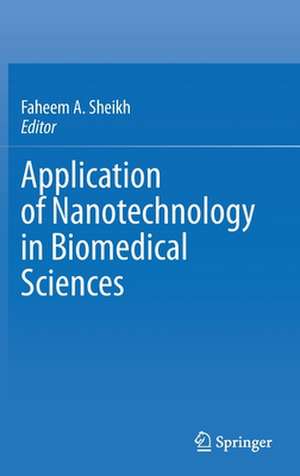Application of Nanotechnology in Biomedical Sciences
Editat de Faheem A. Sheikhen Limba Engleză Hardback – sep 2020
Further, it describes the use of blending and functionalization to produce chitosan nanofibers for biomedical applications, and reviews the role of plasma-enhanced gold nanoparticles in diagnostics and therapeutics. Lastly, the book also introduces various nanotechnology approaches for the removal of waste metabolites in drinking water, and explores the emerging applications of nanorobotics in medicine. Given its scope, this book is a valuable resource for scientists, clinicians, engineers and researchers aiming to gain a better understanding of the various applications of nanotechnology.
| Toate formatele și edițiile | Preț | Express |
|---|---|---|
| Paperback (1) | 939.00 lei 6-8 săpt. | |
| Springer Nature Singapore – sep 2021 | 939.00 lei 6-8 săpt. | |
| Hardback (1) | 944.99 lei 6-8 săpt. | |
| Springer Nature Singapore – sep 2020 | 944.99 lei 6-8 săpt. |
Preț: 944.99 lei
Preț vechi: 1152.43 lei
-18% Nou
Puncte Express: 1417
Preț estimativ în valută:
180.88€ • 196.54$ • 152.04£
180.88€ • 196.54$ • 152.04£
Carte tipărită la comandă
Livrare economică 21 aprilie-05 mai
Preluare comenzi: 021 569.72.76
Specificații
ISBN-13: 9789811556210
ISBN-10: 9811556210
Ilustrații: XIV, 164 p. 63 illus., 49 illus. in color.
Dimensiuni: 155 x 235 mm
Greutate: 0.43 kg
Ediția:1st ed. 2020
Editura: Springer Nature Singapore
Colecția Springer
Locul publicării:Singapore, Singapore
ISBN-10: 9811556210
Ilustrații: XIV, 164 p. 63 illus., 49 illus. in color.
Dimensiuni: 155 x 235 mm
Greutate: 0.43 kg
Ediția:1st ed. 2020
Editura: Springer Nature Singapore
Colecția Springer
Locul publicării:Singapore, Singapore
Cuprins
Chapter 1: Advancements of nanotechnology in diagnostic applications.- Chapter : 2: Polycaprolactone-based nanofibers and their in-vitro and in-vivo applications in bone tissue engineering.- Chapter 3: Nanocamptothecins as new generation pharmaceuticals for treatment of diverse cancers: Overview on a Natural product to Nanomedicine. – Chapter 4: Smart biomaterials from electrospun chitosan nanofibers by functionalization and blending in biomedical applications.- Chapter 5: Unique properties of the gold nanoparticles: Synthesis, functionalization and applications.- Chapter 6 : Nanotechnology and diabetes management: Recent advances and future perspectives.- Chapter 7: Recent advances in the emergence of nanorobotics in medicine.- Chapter 8: Composite of ceramic and polymeric nanofibers for photocatalytic degradation of dairy effluent.
Notă biografică
Faheem A. Sheikh is an Assistant Professor at the Department of Nanotechnology, University of Kashmir, India. Before this, he served as an Assistant Professor at the Department of Biotechnology at the Central University of Kashmir, India (2015–2016); Brain Korea 21+ Research Professor at the Myongji University, South Korea (2014–2015); Assistant Professor Research at Nano-Bio Regenerative Medical Institute, Hallym University, South Korea (2012–2014); Postdoc/Research fellow at the University of Texas Rio Grande Valley, Texas, United States of America (2010–2012); and Research Professor at Myongji University, South Korea (2010). His research mainly focuses on fabricating 3D nanomaterials used in tissue engineering and regeneration. He has considerable expertise in the fabrication of polymeric, ceramic, and metal oxide nanofibers using electrospinning, as well as the production of porous scaffolds by solvent casting, saltleaching, 3D printing, gas forming, sol-gel synthesis, phase separation, freeze-drying, particulate leaching, and self-assembly for hard and soft tissue engineering. He has more than 16 years of research experience in nanotechnology, with a particular focus on new material fabrication, developing new techniques, tissue engineering and drug delivery. He has published over 100 peer-reviewed articles, contributed to 10 conferences, written 7 book chapters, and delivered 4 invited talks.
Textul de pe ultima copertă
This book highlights the wide applications of nanomaterials in healthcare and environmental remediation. Presenting nano-based materials that positively influence the growth and proliferation of cells present in soft and hard tissue and are used for the regeneration bone tissue and/or suppression of cancer cells, it also discusses the natural products that can be incorporated in nanofibers for the treatment of cancer.
Further, it describes the use of blending and functionalization to produce chitosan nanofibers for biomedical applications, and reviews the role of plasma-enhanced gold nanoparticles in diagnostics and therapeutics. Lastly, the book also introduces various nanotechnology approaches for the removal of waste metabolites in drinking water, and explores the emerging applications of nanorobotics in medicine. Given its scope, this book is a valuable resource for scientists, clinicians, engineers and researchers aiming to gain abetter understanding of the various applications of nanotechnology.
Further, it describes the use of blending and functionalization to produce chitosan nanofibers for biomedical applications, and reviews the role of plasma-enhanced gold nanoparticles in diagnostics and therapeutics. Lastly, the book also introduces various nanotechnology approaches for the removal of waste metabolites in drinking water, and explores the emerging applications of nanorobotics in medicine. Given its scope, this book is a valuable resource for scientists, clinicians, engineers and researchers aiming to gain abetter understanding of the various applications of nanotechnology.
Caracteristici
Summarizes the potential applications of nanomaterials in various fields Discusses utilization of nanomaterials in biomedical applications Presents recent advacements on the emerging nanorobotic applications in nanomedicine Reviews the remediation of wastewater using nanomaterials
